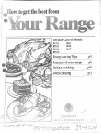
:
;
,,
.,?j
,!-..--,!
‘.. + ,: . .,
: stamwfmmthra
wh
openingov&m’. TIMhot
airo steam which Wq3a
Caw?
mm-mtohands, faceami/
.;
o eyes.
~~
Don’t heUnopenedfood fm
tainersin-theoven. Pressure could
kmiid
up and’the container’could
burcausing an h-lpr’yo
<~ Keep oven vent ducts
‘..
unobstructed.
= Keep oven free from grease
build up.
::: Place oven rack in desired posi-
tion while oven is cool. If racks
must be handled when hot, do not
let potholder contact heating units
in the oven.
I.:JPulling out shelf to the shelf
stop is a convenience in lifting
heavy foods. It is also a precau-
tion against burns from touching
hot surfaces of the door or oven
walls.
~: When using cooking or
roasting bags in oven, follow the
manufacturer’s directions.
.
Do not use your oven to dry
newspapers. If overheated, they
can catch fire.
(“: ; \;,, ‘“...~. - ‘ ; ~, ~!L,-“.,;J . !; ‘-- :.’
;-
I \ \’ . ~ ~;”
}-.
1>1d L 1’L
~
-.. <.4 .<- !’L 2: r! $. Lts- k, , (,
J useProperPan Siz
appi
equipped with one or
more surface units of different
size. Select utensils having flat
bottoms large enough to cover the
surface unit heating element. The
use of undersized utensils will
expose a portion of the heating
element to direct contact and may
result in ignition of clothing.
Proper relationship of utensil
to burner will also improve
efficiency.
9 Never’leave !wn-faceUnits
unattendedat high heat settings.
Boilover causes smoking and
greasy spillovers that may catch
on fire.
G Be sure drip pans and vent
ducts are not covered and are in
place. Their absence during cook-
ing could damage range parts and
wiring.
i:i ~~n’t ~s~ a~umim.mllf~il to tine
drip pans or anywhere in the oven
except as described in this book.
Misuse could result in a shock,
fire hazard, or damage to the
range.
I Only certain types of glass,
..:
glass/ceramic, ceramic, earthen-
ware, or other glazed containers
are suitable for range-top service;
others may break because of the
sudden
chi tem
(SSeo “SCo
f
sugge
TO burns, ignition of
flamata sp
t hao a consh
b posis t i i tu
tot ceo t r
witexto ne
surun
Dcimo s E%
~~.6junDop t
.
i a
dk$h
Q AJturnsurface unit to
OFF before removing utensil.
+~ Keep an eye on foods being
fried at HIGH or MEDIUM
HIGH heats.
Q To avoid the ofa
b o electricshock, always be
certainthat ‘thefmntrds for N
surfaceUnitsm%?at OH? position
and all coils arecool before
attemptingto remove the unit.
0 W flamingfoods u t
hood, turnthe fanoff.The fan, if
q3erating9may spreadthe flame.
Q
F f f s b as
dry as possible. Frost on frozen
foods or moisture on fresh foods
can cause hot fat to bubble up
and over sides of pan.
a Use little fat for effective
shallow or deep-fat frying. Filling
the pan too full of fat can cause
spillovers when food is added.
s If a combination of oils or fats
will be used in frying, stir together
before heating, or as fats melt
slowly.
G Always heat fat slowly, and
watch as it heats.
~ LJsed f th
wh
po
t p o
hef b t s
p


















